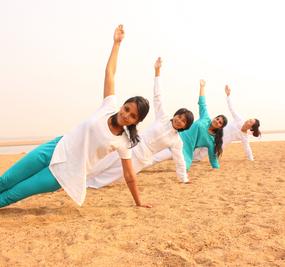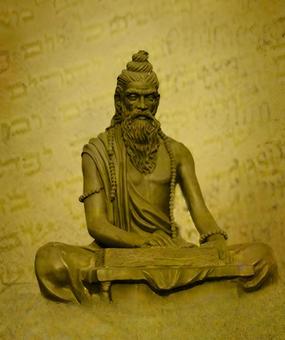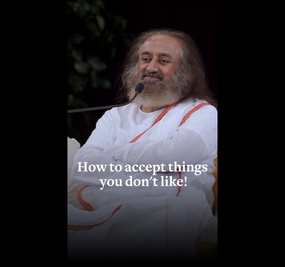Practicing yoga for beginners is much more than the postures. Learning to integrate the full “on and off the mat” practice including observing the five yamas and niyamas—yoga’s guide on social and personal ethics— in your daily life can transform you and your yoga practice. Our thoughts, actions, decisions, interactions with others, our daily routines, our surroundings, everything can reflect the extent of our yoga practice. Only by such inclusive and integrated yoga practice can the ultimate goal of this ancient system be realized: bringing our bodies, minds, and spirits into harmony to make us free from the bondage and miseries of life.
The precious gift of Maharishi Patanjali Yoga Sutras
Taking materials about yoga philosophy from ancient traditions, Maharishi Patanjali, sage scientist and propounder of yoga, wrote 196 sutras (aphorisms) on yoga around 400 CE, popularly known as Patanjali’s Yoga Sutras. In just 196 short sentences, Maharishi Patanjali maps out a complete system of yoga. Each sutra requires the reader to think deeply for themselves and develop a personal understanding of the practice. What an amazing way to transmit spiritual knowledge!
While all the stretching, twisting, balancing is very beneficial, and certainly makes our body healthier and more vibrant, but it is just one limb of yoga. Ancient texts such as the Hatha Yoga Pradipika and The Yoga Sutras focus very little on physical yoga postures (asana practice), and in fact, when Maharishi Patanjali speaks of ‘asana’ he is not at all referring to headstand or warrior or downward dog; he’s talking about the position you choose to sit in while meditating – your asana – ‘seat’.
The second chapter of the sutras is generally considered the one most focused on “practice” of the yogic philosophy and lifestyle; there Maharishi Patanjali details the eight limbs of yoga – known as ashtanga yoga. The following graphic can help you understand the eight limbs at a glance.
What are the five yamas & niyamas?
The five yamas (social ethics) and five niyamas (personal observances) are two of these eight limbs. Ahimsa (nonviolence), satya (truthfulness), asteya (non-stealing), brahmacharya (abstinence), aparigraha (non-accumulation) constitute the five yamas, whereas soucha (internal and external cleanliness), santosha (being happy and content), tapas (penance), swadhyaya (self-study) and ishvarapranidhana (surrender to the higher power) constitute the five niyamas. These 10 guidelines or ethical principles are like ready-made New Year’s resolutions. The yamas primarily focus on our actions when in community with others, while the niyamas focus more generally on our relationship with our physical and psychological selves.
For the majority of modern yogis, it may seem that the yamas and niyamas are two of the hardest of the eight limbs of yoga to blend into our daily routines and our lifestyles. The question, “How do we integrate the yamas and niyamas into our lives?” keeps haunting us, and may leave us feeling guilty or discouraged.
The following graphic can help you understand yamas and niyamas at a glance along with how they benefit us.
Clearing the misconception about yamas & niyamas
The yamas and niyamas are not commandments from on high to follow because we’re afraid of what will happen if we don’t follow them. On the contrary, I see them as practical ways to live life so we can access inner peace, bliss, and love in our day-to-day life, not just momentarily but 24/7. Maybe that is what we can call self-realization or enlightenment.
The practice of the yamas and niyamas definitely inspires us to remember that yoga is a way of life — not just something we do for 90 minutes three times a week on a rectangular yoga mat. In fact, if they are interwoven in every fabric of our life, every moment becomes sadhana (spiritual practice). They add the necessary juice to our practice. Without them, the rest of the eight limbs may become empty, mechanical, and boring techniques.
The late Dr. B K S Iyengar describes both the yamas and niyamas as the ‘golden keys to unlock the spiritual gates’, as they transform each action into one that originates from a deeper and more ‘connected’ place within ourselves. From that state of being, we move closer towards wholeness, connectedness, and unity, and start to not just ‘do’ yoga, but live and breathe ‘yoga’ in each and every moment.
We all desire to have the benefits of practicing these 10 guidelines or observances. But the benefits are often intangible. In our rush to get on the mat, get moving, and get noticeable and tangible results, we may not spend enough time to understand them, practice them, and gauge their benefits correctly.
How to approach the yamas & niyamas in daily life?
There is one approach which sees the eight limbs as steps, and it can lead us to believe that until we follow and master the yamas and niyamas, we cannot practice other limbs and get benefit out of their practice. This approach may raise many self-doubting questions like:
- How can we calm the mind in meditation, when it is full of anger and discontentment?
- How can we experience the stillness in the posture if we are not ready for tapas (penance)?
- How can we enjoy the relaxation in savasana if we are not prepared to let go and surrender?
- How can we go deeper into our breath when our body and surroundings are not clean (shouch) enough?
Explaining the second approach, Gurudev Sri Sri Ravi Shankar, who is my role model and example of a perfect yogi says, “Yoga has eight limbs, like a chair which has got four legs. Each one is connected to the whole. If you pull one leg, the whole chair comes. When the body is developing, the whole body develops together. All the organs of the body develop together. Not that the nose develops first and then the ears come; all the aspects, all the limbs of the body develop simultaneously. That is why Patanjali says that these are all the limbs (not steps) of yoga and they develop simultaneously.”
This understanding, that these eight aspects of yoga are not steps but limbs that grow simultaneously, removes all self-doubts and gives us so much space, freedom and enthusiasm to practice yoga as a whole with a full heart.
Yoga anga anushtanat ashuddhi kshaye jnanadi Apthiraviveka khyatehe’’ (Sutra II – 28)
“By the sustained practice of the eight limbs of yoga, the impurities are destroyed and the light of wisdom, discrimination shines forth.”
Explaining this sutra, Gurudev Sri Sri Ravi Shankar says, “Human consciousness is like a seed. A seed has the possibility of a tree, of the leaves, of a branch, of fruits, of flowers, of multiplication; so also the human mind. A seed needs proper ground, proper conditions, sunlight, water, proper soil for it to sprout and blossom. Similarly human consciousness and the human mind. Either the seed can be dormant for years, keeping its possibility within itself, or it starts blossoming, sprouting. The sprouting of the seed of human consciousness is viveka – discrimination. Freedom comes with viveka – discrimination.”
With this I understand that one need not master the first or second limb of yoga in order to learn the third to the eighth limb of yoga. All eight limbs can be practiced simultaneously. And when we practice all eight limbs together, we have the possibility to fully blossom our human potential. With the practice of eight limbs of yoga, the freedom that comes from discrimination dawns on you.
He further says, “To the extent you practice yamas and niyamas, you will go deeper into your practice and purpose of yoga. There is no need to doubt or analyze yourself too much. Just the intention to practice yamas and niyamas is good enough. Just sow the seeds, keep nurturing them with your practice, and relax. The seeds will sprout.”
This is so empowering. With this approach I find that it becomes easy to make the yamas and niyamas an ingrained part of my daily habits; it motivates me that it is easy to cultivate a full and fulfilling yama/niyama practice in our modern life, without going to the Himalayas.
Finding the sweet
Having understood this approach, the yamas and niyamas of the yoga sutras can sometimes feel like sky-high ideals that may take time (a lifetime or even more!) to cultivate and establish. We may be tempted to ignore or overlook them. But paying attention to them is very necessary. In our world of glamor and instant gratification, it can seem more desirable and important to learn and perfect the triangle pose than to practice kindness and compassion (ahimsa) in every moment. We tend to believe that doing a headstand will be more fulfilling and beneficial than only taking what we need from our planet’s natural resources (aparigraha). It can seem far easier to meditate for 20 minutes a day than to practice contentment (santosha) breath by breath.
The ultimate purpose of practicing the yamas and niyamas is to experience real discipline and freedom in our life. But, I have seen people becoming very hard on themselves and the people around them in their attempt to practice yamas and niyamas. This may happen due to misinterpretation of these principles and forgetting the final purpose of their practice. I also find these 10 principles are so complex and closely interconnected that if I am not fully aware, any linear thinking or misinterpretation of one can lead to the wrong application of the other. It is like walking on a tightrope without losing our balance on either side. For example:
- Aren’t there times when speaking the truth (satya) might cause hurt or harm to you or somebody? Does that mean we are going away from non-violence (ahimsa)?
- Aren’t there times when your inability to keep cleanliness (shaucha) caused you anger and discontentment? Then is this not observing non-violence (ahimsa) and contentment (santosha)?
- We all sometimes tend to indulge in or get contentment (santosha) out of eating not-so-healthy foods that we know cause harm to our body. Does such indulgence take us away from following non-violence (ahimsa)?
- The majority of us have wardrobes that are more than full, and still we keep buying beautiful outfits one after the other to feel happy and content. Does this mean that we are over accumulating and going far away from keeping the vow of aparighraha (non-accumulation)?
The yamas and the niyamas can apply to large, long-term goals for living, as well as the small decisions we make daily in our interactions with others. How do we live with skill and ethics, peace and self-protection, in a world that may not be necessarily following these guidelines so well? In particular, how do we practice these principles when they seem at cross-purposes?
Practice, practice, practice (with reverence) is the way
Despite being on the path of yoga for more than two decades, though I have made good progress, I still feel that I am scratching the surface of putting them into full practice in my life. But having them as goals in my mind and heart keeps the enthusiasm and fire of swadhyaya (the study of the Self) alive in me. It is relatively easy for me to observe and apply the obvious or gross aspects of yamas and niyamas. My challenge and next step are how to apply them at very subtle levels, in letter and spirit. Another challenge is how to integrate them with ease, like a flowing river that doesn’t get stuck despite any hurdles, but finds a way to keep flowing no matter what. And finally, how do I make them a part of me; how does my very being radiate all these beautiful principles. I know this requires great skill, patience, and most importantly grace of the Guru.
Maharishi Patanjali had been generous to give us such insightful guidance, He says –
“Sa tu dirgha kala nairantarya satkara sevito drudha bhumihi” (Sutra II- 14)
“This becomes firmly grounded or firmly established in you when you attend to it for a long time, without interruption and with honor and respect.”
We all want to achieve the coveted position where we have the greatest strength, but also the greatest ease to practice yamas and niyamas. As 21st-century yogis, we need to approach the yamas and niyamas with honor and reverence; as a patient and long-standing practice with sincere trial and error, with a recognition of the nuances inherent in Maharishi Patanjali’s Sutras, and, most importantly, a fairly constant self-assessment that considers all 10 guidelines and all other limbs simultaneously.
Once understood correctly and mastered, these will slowly but surely become our natural habits that can place us in that perfect state of balance. I am extremely hopeful. Our on-the-mat practices of asana, pranayama (breathing exercises), and meditation will help us calm the mind and increase self-awareness and thus will help with the practice of yama and niyama too.
Sejal Shah, E-RYT 500 Sri Sri Yoga Teacher, YACEP, C-IAYT, Meditation Teacher, Happiness expert, NYU Post Graduate Medical School approved Yoga-CME retreat facilitator, Mind-Body Wellness Writer, Homeopath. She can be followed on Instagram, Twitter, and Facebook.
















